Scottish household survey 2019: key findings
An infographic summary of the key findings from the 2019 edition of the Scottish Household Survey, a continuous survey running since 1999 based on a sample of the general population in private residences in Scotland.
Section Three - Housing
Home ownership was the most common form of tenure in Scotland. The proportion of owner-occupier had increased from 61% in 1999 to 66% in 2009, after which it dropped to 62% in 2019.
The proportion of households in the social rented sector had stabilised in the previous decade. The end of the Right to Buy policy and efforts by the Scottish Government to promote affordable housing contributed to stabilising the social rented sector.
The proportion of households in the private rented sector had increased since 1999, from 5% to 15% of all households in 2016, after which it fell slightly to 14% in 2019.
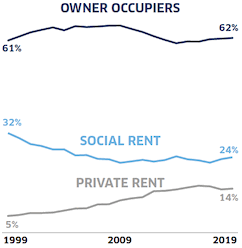
This line graph shows changes in the proportion of households in the main types of tenure from 1999 to 2019. There are three lines: “Owner Occupier”, “Social Rent”, and “Private Rent”, in order of how common they were in 2019. The graph shows owner occupier as consistent and significantly more common than the other forms of tenure, social rent as decreasing and private rent as increasing with time.
Among owner occupiers, an increasing number of households owned their property outright rather than with a loan
Outright ownership increases with age and is the tenure of 66% of households where the highest income earner is 60 or over
7 in 10 households whose highest earner is aged 60 or over are owner-occupiers.
The increase since 1999 was mainly due to an increase in outright ownership from 46% in 1999 to 66% in 2019 in this age group.
Simultaneously, the proportion of those aged 60 or over living in the social rented sector had decreased sharply since the millennium shift.
This could be due to a mix of factors, for example, a change over time in the age structure of households entering social housing and Right to Buy sales.
There was also a small but significant increase in the proportion of older households living in the private rented sector.
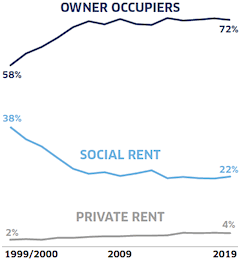
This line graph shows changes in the proportion of households with the highest earner being aged 60 or over, in the main types of tenure from 1999 to 2019. There are three lines: “Owner Occupier”, “Social Rent”, and “Private Rent”, in order of how common they were in 2019. The graph shows owner occupier as the most common form of tenure, and highlights a significant drop in the proportion of households in the social sector.
Households with highest earners 35-59 years old:
In this age group the proportion of owner occupiers had decreased from 69% in 1999/2000 to 63% in 2019
Over the same period, the proportion in the private rented sector increased for this age group
4 in 10 households whose highest income earner was between 16 and 34 lived in the private rented sector – a higher proportion than the average across all age groups.
The proportion of this age group living in the private rented sector increased from 13% in 1999 to 41% in 2015.
Following this, the proportion of private tenants in this age group fell slightly in 2018, and remained at a similar level of 38% in 2019.
The proportion of owner occupier households where the highest income earner is 16 to 34 years old increased from 30% in 2014 to 38% in 2019. This was largely due to these households being able to access mortgages and loans.
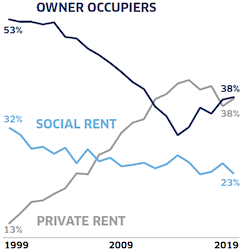
This line graph shows changes in the proportion of households with the highest earner being aged 16 to 34, in the main types of tenure from 1999 to 2019. There are three lines: “Private Rent”, “Owner Occupier” and “Social Rent” in order of how common they were in 2019. The graph highlights a significant increase in the proportion of households in the private rented sector, and general decline in the proportion of owner occupier households.
1 in 6 adults in the private rented sector were in further or higher education
Households in the social housing sector were significantly more likely than households in any other type of tenure to be found in high deprivation areas.
Almost half of all households in the social rented sector were in the 20% most deprived areas in Scotland.
One in every four owner occupied household was in the 20% least deprived areas in Scotland.
Private rented households were spread out fairly evenly across different areas of deprivation.
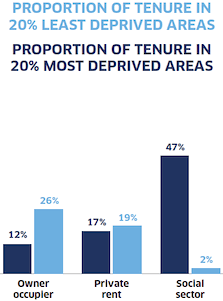
This bar chart shows the proportion of the three main types of tenure (Owner Occupier, Private Rent and Social Sector) in the 20% most and 20% least deprived areas in Scotland. It highlights that there was a higher proportion of households in the social rented sector in the most deprived areas in Scotland, and a larger proportion of owner occupier households in the least deprived areas.
63% of households in the private rented sector had lived at their current address for two years or less
Owner occupiers tended to have lived at their current address the longest, with 56% of households having lived there for eleven years or more
9 out of 10 households were either very or fairly satisfied with their housing.
However, this differed between different housing sectors. 95% of owner-occupier households were either very or fairly satisfied with their housing, while households in both the private rented sector and the social sector report significantly higher levels of dissatisfaction.
Additionally, since 2012 the proportion of households that were very satisfied with their housing significantly decreased. Instead, more households were fairly satisfied.
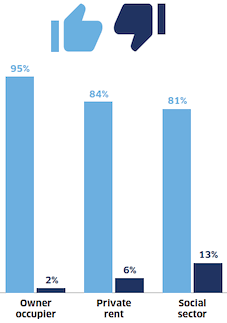
This bar chart shows the proportion of households who are satisfied with their housing next to the proportion who are not satisfied by the three main forms of tenure (Owner Occupier, Private Rent and Social Sector). It highlights that owner occupier households were the most satisfied with their housing, while households in the social rented sector were the least satisfied. All the numbers were relatively high.
The overall proportion of households who were very satisfied with their housing decreased from 58% in 2012 to 52% in 2019
This happened as more households reported to be fairly satisfied with their housing
In the graph, the category ‘neither satisfied nor dissatisfied’ has been excluded.
Contact
Email: shs@gov.scot
There is a problem
Thanks for your feedback